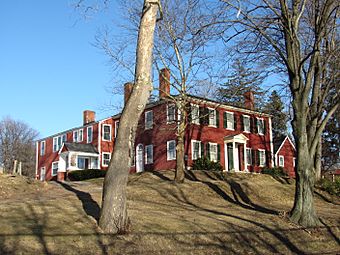Haverhill Historical Society Historic District facts for kids
Quick facts for kids |
|
|
Haverhill Historical Society Historic District
|
|

Haverhill Historical Society
|
|
| Location | Haverhill, Massachusetts |
|---|---|
| Built | 1888 |
| Architect | Perkins, James H. |
| Architectural style | Colonial, Georgian |
| NRHP reference No. | 05000560 |
| Added to NRHP | June 8, 2005 |
The Haverhill Historical Society Historic District is a special collection of old buildings in Haverhill, Massachusetts. These buildings are found at 240 Water Street. The district was added to the National Register of Historic Places in 2005.
At the heart of this district is a beautiful old farmhouse. It was built in the Federal style. This house, along with its land, was given to the Haverhill Historical Society in 1903. The district covers about 1.5 acres (0.61 ha) of land. It sits between John Ward Avenue and the Merrimack River. On this land, you can find four historic buildings. There is also an old archeological site. This site holds the remains of a home from the late 1600s.
Contents
Early History of the Property
The story of this land goes back to the 1660s. It was once the home of Elizabeth Ward and Nathaniel Saltonstall. Nathaniel was the grandson of an early Massachusetts settler, Richard Saltonstall. Nathaniel Saltonstall was also one of the judges during the Salem Witch Trials. These trials were a difficult time in history.
The Saltonstall family owned the property for many years. In the late 1700s, a large part of the land was taken over. This happened because of a mortgage issue. George Watson, who was related to Richard Saltonstall, took possession.
Buttonwoods House is Built
Later, Watson's family sold the property to James Duncan, Sr. It was either James or his son Samuel who built the main house. This house is made of brick and is in the Federal style. It is known today as Buttonwoods. The very old Saltonstall house was taken down around this time.
Adding More Buildings to the District
Sometime in the early to mid-1800s, a second house was built. This house was usually lived in by the farmer who worked the land. It was called the "Ward" house. This house was moved to Eastern Avenue between 1880 and 1891.
The main house and its farmlands stayed with the Duncan family. This was true until 1888. Then, the Duncan family heirs started selling off parts of the farmland. The Buttonwoods house remained with Elizabeth Duncan. She gave it to the Haverhill Historical Society in 1903.
Haverhill Historical Society's Role
The historical society wanted the property for a good reason. They needed a place for their growing collection of old papers and items. The two rooms on the east side of the house were made into a safe storage area. This area was designed to protect materials from fire.
At first, the society's curator lived in the rest of the house. He decorated it and showed off his own collection there. In 1906, the "Ward" house was brought back to the property. It was placed close to where it was believed to have originally stood. Today, the historical society uses this house for special displays. These displays help visitors understand the past.
In the 1920s, the society bought another building. It was a chapel on the north side of John Ward Avenue. They renamed this building Tenney Hall. This building was moved to the main property in the 1980s. This happened after the society sold the land it was on to Linwood Cemetery.
The newest addition to the property is a historic building from the 1860s. It is called a "ten footer." This was a small building where shoes were made. It was added to the property in 1957. All these buildings together make up the Haverhill Historical Society Historic District.



